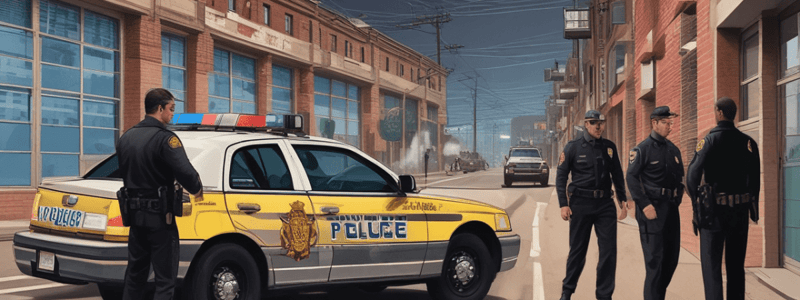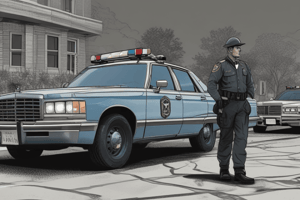Podcast
Questions and Answers
What should be done to ventilate the vehicle when searching occupants?
What should be done to ventilate the vehicle when searching occupants?
- Open windows and doors (correct)
- Turn on the air conditioning
- Keep windows closed
- Open the sunroof
What actions should be taken by the responding supervisor if a Lab is present at the scene?
What actions should be taken by the responding supervisor if a Lab is present at the scene?
Notify the dispatcher, request Metro Meth Section response, request additional officers for perimeter security, establish a controlled entry/exit location, and initiate a Crime Scene Log (Form 227 P.D.).
What report should be completed when a department member is exposed to a hazardous chemical substance?
What report should be completed when a department member is exposed to a hazardous chemical substance?
Hazardous Chemical/Substance or Clandestine Laboratory Exposure Report, Form 9 P.D.
Gas mask filters are effective at protecting members from chemical vapors found at Lab scenes.
Gas mask filters are effective at protecting members from chemical vapors found at Lab scenes.
Match the following items with their correct descriptions:
Match the following items with their correct descriptions:
What does a Clandestine Laboratory (Lab) consist of?
What does a Clandestine Laboratory (Lab) consist of?
What does 'Exposed' mean in the context of hazardous substances?
What does 'Exposed' mean in the context of hazardous substances?
A Hazardous Chemical/Substance or Clandestine Laboratory Exposure Report, Form 9 P.D., must be completed for all members who are required to make entry or any other member who is at the scene and has been exposed to a lab.
A Hazardous Chemical/Substance or Clandestine Laboratory Exposure Report, Form 9 P.D., must be completed for all members who are required to make entry or any other member who is at the scene and has been exposed to a lab.
Annex B of the directive provides information on Contamination and ____________________.
Annex B of the directive provides information on Contamination and ____________________.
Flashcards are hidden until you start studying
Study Notes
Clandestine Laboratory Operations
- A Clandestine Laboratory (Lab) is an illicit operation that manufactures, cultivates, or synthesizes controlled substances, explosives, or biological/chemical weapons.
- Exposure to a Lab can cause death, disease, or physical injuries due to hazardous chemicals and substances.
General Guidelines
- The Kansas City Missouri Police Department prioritizes member safety when dealing with Lab operations.
- Maximum effort will be made to provide members with information on Labs and necessary precautions.
- The Communications Unit Supervisor should be notified whenever a Lab is suspected.
- The Metro Meth Section should be contacted 24/7 for Lab-related information.
Operations Procedures
- Initial safety actions at a Lab scene:
- Do not enter or re-enter the scene after initial discovery.
- Evacuate at the first sign of potential danger or exposure.
- Follow procedures for explosive device calls.
- Request a supervisor to respond.
- Secure the area and establish a controlled entry/exit location.
- When encountering a suspected Lab:
- Be attentive to items in plain view.
- Check for exterior indicators of an internal Lab.
- Be cautious of concealed traps.
- Ensure no one enters the premises.
- Provide medical attention, if necessary.
Suspected Lab - Call for Service/Residence Check
- If a member suspects a Lab during a call-for-service or residence check:
- Follow initial safety actions.
- Be attentive to items in plain view.
- Check for exterior indicators of an internal Lab.
- Ensure no one enters the premises.
- Provide medical attention, if necessary.
Suspected Lab - Traffic Stop/Car Check
- If a member encounters a Lab during a traffic stop or car check:
- Remove self and occupants from the vehicle.
- Detain the occupants.
- Do not move the vehicle or touch anything inside.
- Divert traffic around the vehicle.
- Be aware of sharp objects and possible Lab items.
- Request a supervisor to respond.
Response and Reporting
- The responding supervisor will evaluate the situation and request necessary responses.
- A Metro Meth Section supervisor and/or detective will have overall authority and responsibility for the scene.
- Appropriate reports will be completed, including:
- Hazardous Chemical/Substance or Clandestine Laboratory Exposure Report (Form 9 P.D.)
- Injury Report (Form 314 P.D.)
- Suspected Narcotics Activity Report (Form 115 P.D.)
Contamination and Decontamination
- Contamination can occur through skin contact, inhalation, or ingestion.
- Disposable gloves and chemical barrier gloves should be worn.
- Members should avoid touching their body, eating, or drinking near the scene.
- Decontamination will be determined by the Site Safety Officer.
- Persons who are contaminated will receive medical attention.
Chemical Recovery
- The department chemist will coordinate the disposal of hazardous chemicals with the Metro Meth Section.
- The KCFD Haz-Mat Team will be responsible for cleaning up chemical spills.
- Chemical recovery will be treated as a criminal offense and will require the response of the Metro Meth Section.
Concealed Traps
-
Concealed traps can be encountered at Lab scenes.
-
Types of traps include small foil balls containing strong oxidizers, reactive metals, and solvents.
-
Extreme caution should be used when entering a Lab, and members should refrain from touching anything at the site.### Explosive Devices and Booby Traps
-
Extremely shock sensitive and unstable explosives, typically ranging from marble to golf ball size, can be used to harm individuals.
-
Booby-trapped light switches, flammable liquid containers, and light bulbs can be rigged to detonate and cause harm.
-
Refrigerator doors and internal light bulbs can be wired to detonate an explosive liquid when opened, posing a threat to individuals accessing the appliance.
-
Mock video tape cassettes can be altered to detonate an internal explosion when placed into a video player, making them a potential hazard.
-
CO2 cartridges, gun barrels, steel pipes, and dummy pineapple grenades can be filled with explosive material and connected to a detonation device, posing a significant threat.
-
A hydrogen cyanide gas generator can be created using a makeshift container with acidic chemicals designed to spill onto a toxic chemical, releasing a deadly gas.
-
Leaving open, flammable liquids adjacent to incendiary devices can ignite and cause harm.
-
Attack dogs and poisonous/dangerous snakes can be used as a form of booby trap to harm individuals.
-
Monofilament trip lines can be connected to chemical or explosive booby-traps and/or firearms, such as an explosive device or shotgun rigged to a doorknob, doorway, or main entryway.
-
Compressed gas cylinders with discolored valves can be a sign of a potential explosive device.
-
Camping coolers or thermoses can be used to conceal explosive devices or harmful materials.
Studying That Suits You
Use AI to generate personalized quizzes and flashcards to suit your learning preferences.




